
Editorial - July 2008

In the last few days, Rick Vanner and Lee Bamber decided to try something new; so they climbed to the top of Mount Snowdon! (You can still sponsor them here, the British Heart Foundation will be rewarded for their efforts). Admittedly it's a little extreme and there are easier ways to get physical and do something different - without climbing a mountain to do it.
July is the month for everyone to try out something new. You'll find all the details in the newsletter, but it's worth highlighting that you can now get the new trial of DarkBASIC Professional with the latest updates included, and it also comes with a trial of Dark Physics. It's a special extended-time version to allow you to win some great prizes too in the NVIDIA PhysX competition.
FPS Creator is not to be outdone; it is also free and you can find out how to download and use it - with no limitations - in this newsletter. So if you are new to DarkBASIC Professional, Dark Physics, or haven't yet dabbled in the world of FPSC, now is the time!
Until next time,
Happy Coding!

contents
(1) Competition (2) Convention '08 (3) DarkBASIC (4) Soft Bodies (5) FPSC for free (7) TGC Store - Music (8) Realm Crafter (9) Lee's Tip of the Month (11) Recursion (12) Deferred Rendering (13) Videos (16) PlayBasic (17) Winner (18) Outro
NVIDIA Physx Demo Competition

NVIDIA PhysX Competition
The Game Creators and NVIDIA are giving you budding game developers a chance to show off your skills while playing around with PhysX, the hottest game technology to hit the streets in years. Winners will not only walk away with the fastest graphic card technology on the planet, but will see their showpieces distributed to millions of NVIDIA users. The creators of the best submissions will also be considered for potential contractual work with NVIDIA later in the year.
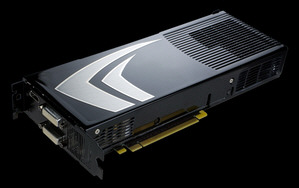 Prizes have been provided by ASUS and EVGA
Prizes have been provided by ASUS and EVGA
Submissions can be from individuals or teams, see rules for full details.
NVIDIA's PhysX engine has been adapted to leverage the complete capabilities of the GeForce family, and Dark Physics has been updated to take full advantage of this.
The Competition Categories
Category A: PhysX feature demos
Within this there are five different sub-categories to choose from. You can send entries for any of these categories and there are no limits on how many you choose to enter.
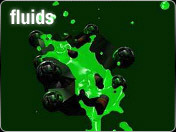 Fluids
Fluids
PhysX using a technology called SPH - Smooth Particle Hydrodynamics. This is a long name which means simply mind blowing fluid effects. This demo should feature fluid simulation in a creative and visually stunning scenario.
The most interesting display of PhysX fluids will win one of the latest NVIDIA Graphics cards.
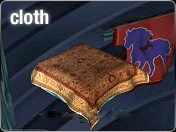 Cloth
Cloth
The cloth features in PhysX are very extensive. Cloth is very versatile, from capes or window drapes to deformable metal effects. Use your grey matter and come up with a smart way to show what you can do with cloth.
The cloth demo that impresses the judges most will win one of the latest NVIDIA Graphics cards.
 Rigid Bodies and Force Fields
Rigid Bodies and Force Fields
Rigid bodies are used extensively in games these days. PhysX Force fields allows the creation of dynamic 3D forces , like wind or magnetic attraction. This Demo should leverage both technologies in a creative way.
The Rigid Bodies / Force Fields winning entry will receive one of the latest NVIDIA Graphics cards.
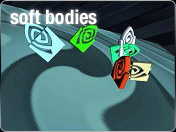 Soft Bodies
Soft Bodies
This new technique is so fresh it hasn't been used in mainstream games - so here's a chance to do some seriously lead edge stuff, just use your imagination. Perhaps a slow puncture on a truck or jelly building blocks, show us what you can do
Top of the class in this category will earn the winner one of the latest NVIDIA Graphics cards.
The images alongside the categories are taken from the current demos, and represent the minimum standard for entry - we are sure talented users from our community can blow these away and show us some awesome physics fun!
We have supplied you with the DBPro source code to these demos. You can adapt the source code to make more compelling versions or just use it to learn how the commands work.
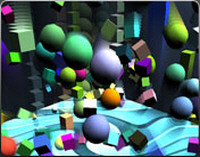 Category B: Uber Demo
Category B: Uber Demo
These demos should "knock our socks off". They should use all core PhysX features (fluids, force fields, soft & rigid bodies ).
This category spans two phases, the first of which will determine who gets the chance to go through and win the main prizes for this competition.
The winning Uber Demos will walk away with the latest NVIDIA hardware, including motherboards and graphics cards.
How To Enter
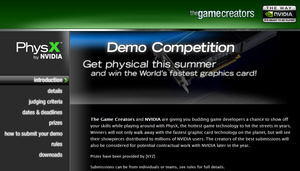 To get the full details of the competition, including the rules, how to enter and how to submit your creations, go to the competition pages on The Game Creators website. There you will find everything you need to know, including the full details of the prizes on offer.
To get the full details of the competition, including the rules, how to enter and how to submit your creations, go to the competition pages on The Game Creators website. There you will find everything you need to know, including the full details of the prizes on offer.
Good luck, and we look forward to seeing your entries soon!
DarkBASIC Professional + Dark Physics Trial
![]() To open up the competition to as many people as possible and provide a taste of the power of DarkBASIC Professional combined with Dark Physics, we are releasing a trial version of both products. You can download them now, we hope you will use them to stun the judges in the competition!
To open up the competition to as many people as possible and provide a taste of the power of DarkBASIC Professional combined with Dark Physics, we are releasing a trial version of both products. You can download them now, we hope you will use them to stun the judges in the competition!
The trial version will expire at the end of September 2008. This gives you plenty of time to explore the many facets of physics, from the basic building blocks of Rigid Bodies, to complex interactions between magnetic forces and highly detailed cloth simulations. Should you make it through to the final stage of the Uber demo, this version will take you right through to the closing date.
The TGC Official Convention 2008

In order to secure your place, accommodation and allow you to plan your travel arrangements, now is the time to place your booking for the 2008 TGC Convention. The date this year is the weekend of the 11th and 12th October, with accommodation available from the Friday. The venue is Hinsley Hall in Leeds, West Yorkshire.
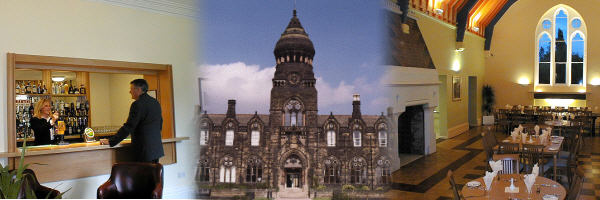
Attending this event will be Rick Vanner and Lee Bamber, the founders of the company and driving force behind what has been and what is yet to come. Joining them will be Mike Johnson, Dave Milton and Paul Johnson, the names behind much of the development that is ongoing, some of which will be revealed at the convention. Rich Davey, former TGC webmaster and newsletter editor will be joining the team in Leeds to meet up with everyone once again.
Lee has provided two hints on the topics he will present. The working titles are Stereoscopics, and Have your own Command in DarkBASIC Professional! If you want the full story behind the headlines, book your place now!
Convention Day Rate - £32.00 per day (£64.00) Convention Attendance | Full Weekend Rate - £180 Convention Attendance |
Most of the accommodation is en-suite, but it is advisable to book early to guarantee your room. Other parties will also be using the facilities and booking rooms.
You can download the booking form here, and return it with a small deposit to reserve your place. We are very excited about this event, and hope that you will take advantage of this unique opportunity. Find more details and join in the discussions on the forums.
DarkBASIC Professional Round-up

Upgrade 6.9 Secret Commands
Did you know that there are a number of commands in Dark Basic Professional currently shrouded in darkness? They exist as undocumented features within the language, accessible only to those who discover them by chance. The main reason they remain hidden relates to the fact they are what are termed work-in-progress features. That is, they implement a certain level of functionality but that functionality is not clear and predictable enough to cement into the official documentation. Once a command attains official status, it remains there for many years and so must stand the test of time. Many of the secret commands have proved to be reliable and useful, and so we have decided to overhaul the help system to include many of these commands for you to enjoy as an official part of the language. Watch out for these additions in Upgrade 7.0 of DarkBASIC Professional!
If you simply cannot wait that long, we have decided to give you a taste of things to come. Below is a list of commands soon to be added to the official help files:
3dmaths
- get matrix4 element
basic3d
- calculate object bounds
- exclude limb off
- exclude limb on
- limb collision
- limb hit
- make emitter
- perform checklist for onscreen objects
- set object mask
camera
- set camera clip
- set cameras to stereoscopic
core
- free string
- get dx version$
- perftimer
- printc
display
- desktop height
- desktop width
- window exist
- window to back
- window to front
file
- can make file
- executable running
- execute executable
- mydocdir$
- read filemap string
- read filemap value
- stop executable
- write filemap string
- write filemap value
ftp
- http connect
- http disconnect
- http request data
image
- close imageblock
- delete icon
- exclude from imageblock
- image file exist
- image height
- image width
- load icon
- open imageblock
- perform checklist for imageblock files
- save icon from image
input
- get key state
light
- ambient light
memblocks
- make array from memblock
- make memblock from array
sprite
- set sprite resize
- sprite priority
system
- call dll x
- checklist fvalue a
- checklist fvalue b
- checklist fvalue c
- checklist fvalue d
text
- append$
- compare case$
- find first char$
- find last char$
- find sub string$
- first token$
- next token$
- reverse$
More details of these commands and how to use them will follow with a future update to DarkBASIC Professional.

The feature outlined here - a Channel 4 production in the UK - is of particular interest to anyone wanting to know if games written in DarkBASIC Professional can make the grade in the commercial world. Dead Ends, an educational Grand Theft Auto-styled game, forms a significant part of this season of documentaries. It is written in DarkBASIC Professional by RollingSound, and aims to educate through computer gaming. Young people were integral to the process and were involved in storyboarding, scripting, acting, animating and testing the game. For some young people this project has paved the way for full-time work in the video games design and media sectors.
"Disarming Britain", a gun and knife crime season of programmes on Channel 4, takes an unflinching look at the increasing violence and use of weapons by young people on our nation's streets.
In support of this season several initiatives have been developed to encourage young people, the group most affected by street crime, to express their views on the issue.
A partnership with Bebo, a leading online social network for young people, sees the creation of 3 fictional profiles (victim, witness, and ex-gang member) that will be introduced over consecutive weeks. Developed using young people and based on real-life experiences these seek to fuel debate and opinion in a familiar and trusted environment. Sushil, the second profile in the series will also have a cameo role in the web drama Sofia's Diary in a continuation of a story line involving knife crime.
All discussions within the profiles are being closely monitored by C4 journalists who may use their comments to form part of a submission to the Street Weapons Commission chaired by Cherie Blair.
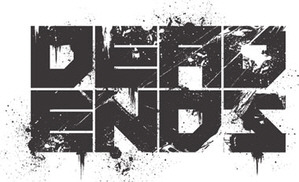 A further initiative sees Channel 4 launch Dead Ends, an educational anti-Grand Theft Auto style game targeted at schools around the country. Part-funded by C4 and developed by Rolling Sound, in conjunction with young people from all over London, it aims to raise awareness among young people of the harrowing consequences of knife crime. Young people were integral to the process and were involved in storyboarding, scripting, acting, animating and testing the game.
A further initiative sees Channel 4 launch Dead Ends, an educational anti-Grand Theft Auto style game targeted at schools around the country. Part-funded by C4 and developed by Rolling Sound, in conjunction with young people from all over London, it aims to raise awareness among young people of the harrowing consequences of knife crime. Young people were integral to the process and were involved in storyboarding, scripting, acting, animating and testing the game.
Finally, in an effort to capture the opinions of those living in areas of high-street crime, Channel 4 will be running a series of challenging and evocative street based events created and run by renowned New York Urban Artist, Paul Notzold. Coined "Txtual Healing", these events use public space in order to explore notions of community through public story telling. Integrating SMS activity with socially charged graphics, featuring images of street crime, projected onto public spaces in London, the public will be invited to interact and see their opinions form part of the art. Channel 4 will be hosting a series of events in Brick Lane and Shepherds Bush from 9pm on the 26th and 27th June.
![]() The season of begins on C4 on the 30th June. You can download Dead Ends, read and watch more about the production on the Channel 4 website.
The season of begins on C4 on the 30th June. You can download Dead Ends, read and watch more about the production on the Channel 4 website.
Qmidi, Freeware Music Composer
Qmidi is the product of three forum members, namely SMD3D Interactive, Chunks and Rudolpho. The comprehensive set of features of this MIDI-based music suite include:
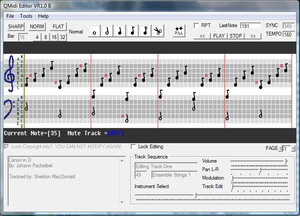 10-track composition area
10-track composition area- Paintbrush-like note composing
- Modulation control
- Pan adjustment
- Individual volume controls
- Tempo speed adjustment
- Octave change settings
- Mute track settings
- Pitch bending
![]() As well as outputting MIDI tracks, the compositions can also be converted to Wav, Ogg and MP3 formats. For full details, and to download the composer, visit the forum thread.
As well as outputting MIDI tracks, the compositions can also be converted to Wav, Ogg and MP3 formats. For full details, and to download the composer, visit the forum thread.
The Dark Physics guide to Soft Bodies
by Mike Johnson
The Theory
The soft body feature of Dark Physics allows the simulation of volumetric deformable objects. It can also be used for items that are not usually thought of as classical soft bodies, such as plants or multiple layers of cloth. To understand better what a volumetric deformable object is, here is a comparison with Dark Physics cloth:
Cloth CharacteristicsRepresented by a triangle mesh A cloth is a surface The triangle mesh is used for simulation The artist's triangle mesh can | Soft Body CharacteristicsRepresented by a tetrahedral mesh A soft body is a volume The tetrahedral mesh is used for A tetrahedral mesh has |
To simulate complex geometry like a tree with many branches and leaves, a coarser volumetric mesh is first built around the object. The volumetric mesh is then simulated and moves the complex geometry with it. The advantage of the technique is that it makes the simulation of triangle soups possible, i.e. every possible mesh can be simulated.
The Content Pipeline
- The artist creates a detailed triangle mesh, possibly with textures, bump maps etc.
- A tool is used to create a coarser tetrahedral mesh around the triangle mesh. (We provide tools for this purpose, which are illustrated in the PhysXViewer sample application)
- The tetrahedral mesh is simulated using the NxSoftBody and NxSoftBodyMesh classes.
- The original triangle mesh is deformed along with the tetrahedral mesh by the user.
- The triangle mesh is displayed on the screen.
Visualising Soft Bodies
The following images show a tetrahedral mesh (middle, right) that was generated for a triangle mesh (left). The right most image, a cut-through of the tetrahedral mesh shows that it covers the volume.

The process works for arbitrary triangle soups like the palm tree. The image on the right shows how the original triangle soup is embedded in the tetrahedral mesh which is shown in wireframe mode.


Creating Soft Bodies
In order to create a soft body it is first necessary to make a tetrahedral mesh file using the PhysXViewer (available from http://developer.nvidia.com/object/physx.html). It will also be necessary to supply a model file to represent the soft body visually inside your program. When these two components are in place use the command:
phy load soft body ID, tetrahedral mesh$, mesh$ X#, Y#, Z#
The initial parameter is an ID number; these numbers are shared with those from Basic3D. Secondly pass in a link to the tetrahedral mesh e.g. mymesh.tet. The second step is to pass in the object mesh (e.g. mymesh.dbo) and finally a position in world space.
Attachments
For collisions between multiple soft bodies it is necessary to add an attachment. It is possible to attach a box, sphere or capsule to the soft body using the commands:
- phy attach soft body capsule
- phy attach soft body sphere
- phy attach soft body box
This forms the basics of soft body implementation. Experimenting will highlight many and varied uses, effects and techniques that will expand the possibilities of your game immensely.
Get FPS Creator for Free!

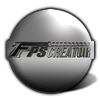 FPS Creator is now available for free! The Game Creators are offering two new methods of grabbing the software that unleashes your creativity and helping you to get started on your next masterpiece. The first option is to take the free download directly from our site. You will get the same editor and design features that are built in to the full version. Multiplayer and the ability to build a standalone game are disabled, although the option to upgrade at any time is available through The Game Creator Store, directly through the editor.
FPS Creator is now available for free! The Game Creators are offering two new methods of grabbing the software that unleashes your creativity and helping you to get started on your next masterpiece. The first option is to take the free download directly from our site. You will get the same editor and design features that are built in to the full version. Multiplayer and the ability to build a standalone game are disabled, although the option to upgrade at any time is available through The Game Creator Store, directly through the editor.
 The second way of getting FPS Creator for free is via TrialPay. The way it works is simple; sign up for a trial of any of the services available from the TrialPay partners - such as DVD rental or setting up an eBay account - and in return you can download the full, no limitations version of FPSC. Many of the offers are trials which can be cancelled before any payment is made, although you might find the services on offer are just as enticing as FPS Creator for free.
The second way of getting FPS Creator for free is via TrialPay. The way it works is simple; sign up for a trial of any of the services available from the TrialPay partners - such as DVD rental or setting up an eBay account - and in return you can download the full, no limitations version of FPSC. Many of the offers are trials which can be cancelled before any payment is made, although you might find the services on offer are just as enticing as FPS Creator for free.
|
|
![]() To get FPSC Free, click on the download link here.
To get FPSC Free, click on the download link here.
![]() To get FPSC through TrialPay, use this link to proceed to their site.
To get FPSC through TrialPay, use this link to proceed to their site.
FPS Creator Upgrade 1.11
 Two updates have been released since the last newsletter and aside from the usual collection of tweaks and fixes, there are a few enhancements too.
Two updates have been released since the last newsletter and aside from the usual collection of tweaks and fixes, there are a few enhancements too.
Windows Vista and FPSC
With the increased take up of Windows Vista, we have added code to ensure that anyone running FPS Creator on this newer operating system has a better experience. We have added code to detect if you are not running in Administrator mode or not running in an 'elevated' mode. Even if you are running in Admin mode, you will still run your applications unelevated if you have UAC switched on. If the application is not elevated, a message will prompt you of this. In addition, we have added manifests to all the FPS Creator executables which instruct Vista to elevate them so they can function normally. FPS Creator was designed long before Vista was available and has not been designed with Vista permissions in mind. Using this new upgrade will help resolve some of these difficulties.
Enhancements to serial code validation
Another important addition is the detection of unknown or black-listed FPSC serial codes at start-up. If the serial code is not valid, the software will still run now, albeit in free mode. This still allows you to use the software, but BUILD GAME and MULTIPLAYER are disabled until a valid serial code is entered. To combat piracy, the black-list is a collection of FPSC serial codes that have somehow escaped from their true owners and entered the public domain. Don't worry if your software enters free mode with the latest update, simply make a backup of your important files and re-install your original FPS Creator product. It is likely your installation information was erased at some point since your last installation of the software. If you have any difficulties in this area, you are welcome to contact our Support Mail center for advice or to have your serial code resent to you.
For the benefit of free version users, we have also added an INSTANT UPGRADE item within the Game Creator Store which allows you to use points to instantly upgrade FPS Creator with the BUILD GAME and MULTIPLAYER features, as well as granting a commercial license to sell what you make.
More new features
There are a few additions to the game engine itself, the coolest being the manual footfall system for characters. Instead of a prefixed footfall sound that relies on a regular walk/run animation, artists can now specify exactly which frame causes the footfall sound effect. This means characters can stumble about with accurate walking noises, and it even opens the door to multi-limbed creatures like spiders and centipedes which might have more than two legs.
The long awaited PLAYERDROP action has been fixed which now opens up the possibility to collect items, drop them elsewhere in the game or have the items slip out of the players hand during the game. A new script called PICKUPSLIPPY.FPI has been added to make this feature a simple matter to implement for your items.
Finally, to help us respond quicker to bug reports, we have added a version number system to the bottom right of any test game, so any screenshots emailed or posted on the forum will clearly indicate which version was responsible for the scene. As more features are added to the game engine, knowing which version you have has become much more important.
Finally, a big thank you to all the FPSC users who have helped us hammer out the last few upgrades. Without your constant feedback, the engine would not be as strong as it is and hopefully with your continued involvement, we can make FPS Creator even better!
Tutorial Videos are now multi-lingual
 Our suite of FPS Creator X10 training videos have now been translated into four more languages. You can get the full set of seven episodes in French, German, Spanish and Italian. They are a great way to get started with FPSC X10, and we hope many more people will take advantage of this valuable resource. They are, of course, all available in English too! To give you a quick preview, here is the first lesson, in German:
Our suite of FPS Creator X10 training videos have now been translated into four more languages. You can get the full set of seven episodes in French, German, Spanish and Italian. They are a great way to get started with FPSC X10, and we hope many more people will take advantage of this valuable resource. They are, of course, all available in English too! To give you a quick preview, here is the first lesson, in German:
![]() All of the links can be found on the forums, in this thread.
All of the links can be found on the forums, in this thread.

iD Tech Camps in the US are now offering the 3D Video Game Design Camp, featuring FPS Creator. Aspiring game designers in this video game camp will build not only a single player game but also learn how to make a multiplayer map to play against friends. For a truly interactive 3D gaming experience, don't miss this opportunity to let your imagination take you to a whole new realm.
iD Tech Camps students receive the highest caliber technology education any summer camp has to offer. Students in this summer camp for kids and teens will be able to move along faster and more independently, or collaborate utilizing our customized lessons-while still receiving gold standard 1-on-1 instruction (average 6 students per staff). Using the latest in hardware and software, our all-adult staff works hands-on with each student from project theory to completion.
![]() For full details, go to the iD Tech Camps website.
For full details, go to the iD Tech Camps website.
The Game Creator Store adds Music for the Masses
 After a successful launch of The Game Creator Store, the range on offer is being extended in July to include music. In just the same way that you select and download models now from within FPSC, music can be included in your selection too. When you're almost ready to publish your game, and need some atmospheric backing music, a ghostly undertone or heart-racing beat to bring it all together, it is now just a few clicks away and you don't even have to leave FPS Creator to get it!
After a successful launch of The Game Creator Store, the range on offer is being extended in July to include music. In just the same way that you select and download models now from within FPSC, music can be included in your selection too. When you're almost ready to publish your game, and need some atmospheric backing music, a ghostly undertone or heart-racing beat to bring it all together, it is now just a few clicks away and you don't even have to leave FPS Creator to get it!
You may recall that last month the announcement on upgrade 1.09 included details of enhancements to background music, allowing it to be changed on the fly. The new library of music coincides very nicely, bringing together the new features with the media to take full advantage of them.
Look out for this new addition in July, when it will be made available through an automatic update to FPS Creator.
If you're a budding artist or musician then get in touch to sign up to be a Game Creator Store Seller.
Realm Crafter - Make your own MMORPG

The Realm Crafter MMORPG engine gives you the power to create your own multiplayer online role-playing game. The Realm Crafter engine was designed for anyone interested in creating an MMORPG, from those with no coding skills to the experienced game programmer. You can use the engine to create everything from a hobby game for you and a few friends, to a large multiplayer commercial game where monthly subscriptions are charged.
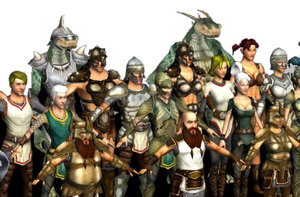 The Realm Crafter MMORPG creation engine comes with a complete set of content. There are over 100 character, monster, animal, tree, plant, prop, interior and building models, but of course you can add your own library of media to your games to make them unique.
The Realm Crafter MMORPG creation engine comes with a complete set of content. There are over 100 character, monster, animal, tree, plant, prop, interior and building models, but of course you can add your own library of media to your games to make them unique.
The Realm Crafter MMORPG creation engine is designed to give you the flexibility to create a game as unique as you want it to be. The engine will run right from the offset in a configuration that produces great results. However, it can be easily customized to suit your game style and theme. The Realm Crafter engine creates a re-distributable client as part of the game creation process. Your game players need only install your game client to play.
The Development Suite
The Realm Crafter engine comes with several powerful editors. These editors are part of the Realm Crafter MMORPG development system.
- The General Editor
- Scripting Editor (with Quest Wizard)
- Armoury
- Terrain Editor
- Tree Maker
- Architect
- Rock Maker
![]() The volume of features are too numerous to mention here. The Realm Crafter pages on the TGC website contain a wealth of information about the product, and you can also order the product directly from this mini-site.
The volume of features are too numerous to mention here. The Realm Crafter pages on the TGC website contain a wealth of information about the product, and you can also order the product directly from this mini-site.
Lee's Tip of the Month - Are Your Games In Shape?

If not, some physical exercise would not hurt, and it just so happens we have a solution called DarkPHYSICS which makes this as easy as falling off a log. Another good reason to flex your physics is to increase your chance of winning our new competition featured elsewhere in this newsletter.
The new trial version of DBPro and DarkPHYSICS contains extensive help, tutorials and example projects to get you started, so I do not want to re-invent the wheel by repeating information you can find elsewhere. Instead, I want to reveal a little tip that you will not read about in any help system but is of great importance to achieving real world reactions during your physics simulations.
DarkPHYSICS works by taking a regular DBPro object and granting it physical properties that the built-in physics engine uses to cause the object to interact with a larger physical environment. Your first programs will probably involve a sphere falling onto a floor and rolling away, but even at this very early stage you will be asking yourself why does the sphere glide to the floor as though watching the event in slow motion?
The answer is that your human perception of scale believes the sphere you have created to be the size of a football, when in fact the physics engine understands the sphere to be the size of a hot air balloon!
Try it for yourself with the code below:
phy start
make object sphere 1,100
phy make rigid body dynamic sphere 1
do
phy update
sleep 1
loop
This will create a typical sphere in DBPro and allow physics gravity to take control of it. Now change the size of the sphere to 1 and see the difference in how quickly it picks up speed during the decent.
The rule then is to be very mindful over the size of objects in your world. Any object that measures several hundred units wide is going to be a very BIG object as far as your physics engine is concerned, so before you launch into content generation and demo writing, create a few quick prototypes and play with the size of your objects and the forces you wish to apply to them. It will save you having the nightmare task of rescaling your entire application, or worse still scrapping it. Done correctly, you will be stunned at how much fun physics can bring to the creative process. Done brilliantly, you could be walking away with some amazing prizes!!
Recursion Mini-Competition Results
Last month, we set you the challenge of being creative with recursion. A few of you did exactly that with some interesting, useful and fun results. From fractals and pattern generation, to managing tribes and planets, the community has shown some practical uses for recursion.
In the end, there were two entries that could not be separated, they both stood out as being particularly useful to game design, but in different arenas.
Tribes
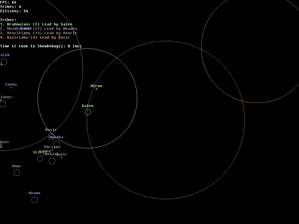 by Sunflash
by Sunflash
This demonstration has its roots in the game of life - entities are created, and they live or die as their dependencies change. Tribes goes several steps further. The detail is best left to the author:
"The program simulates a tribal system by monitoring the male tribal members. The simulation starts with a male, which reproduces a child, who again will reproduce, etc, etc. Eventually the leader of the tribe (the first male) will die of old age, and his sons will split into their own tribes. If the leader only had one son, then that son becomes the new leader of the tribe. Tribes war with each other and will eventually die off. This keeps the population to a reasonable amount."
Planet Patches
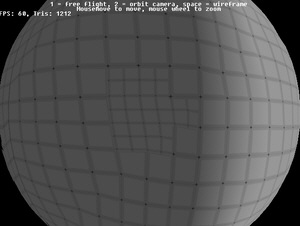 by Dark Coder
by Dark Coder
This implementation of a LOD system for planets is created using DarkGDK. Rather than replace entire objects as the camera moves closer, "patches" of the planet are replaced with smaller patches of increasing detail. As you spin the globe, those patches that come into view become the focus of detail, as those that leave the centre of the viewport lose their resolution. As well as the code, Dark Coder imparts further advice on the graphical element of this technique:
"This is far more optimized than my previous attempt in DBP, infact when benchmarking it the only real slowdown was caused by trying to update the meshes, which is quite slow. I tried 4 methods to update the mesh and the fastest I found was to just delete the limb (the terrain uses) and add another limb of the same ID again".
![]() Congratulation to both winners, please contact us to claim your prize! You can download these and other recursion examples in the forum thread.
Congratulation to both winners, please contact us to claim your prize! You can download these and other recursion examples in the forum thread.
Deferred Rendering Whitepaper
josh Klint, creator of Leadwerks Engine 2.0 featured in issue 64, has produced a Whitepaper on some of the underlying technologies. Deferred rendering is a technique used in the engine to decouple the scene lighting, and improve output and efficiency by introducing the lighting as a post-process. In his paper, Josh explains the detail of this process and how it is achieved in the engine.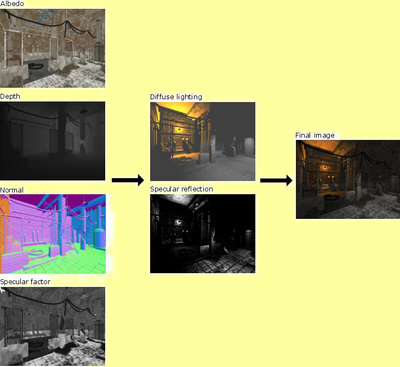
Leadwerks Engine 2.0 utilized a forward renderer. In order to optimize the engine to render only the visible lights onscreen, we implemented a concept we call "shader groups". Instead of storing a single shader per material, the engine stores an array of versions of that shader, each auto-generated using GLSL defines to control the number of lights and other settings. This approach suffered from several problems that became apparent once we started using the engine in a production environment:
- Each shader group had over 100 potential versions. The constant shader compiling during runtime when entering a new area caused unacceptable pauses. Although
- only a few variations ever got compiled and used, it was impossible to guess which ones would be needed. Because there were so many potential variations it was impossible to pre-compile all of these.
- The length of the shaders became quite long, causing slower compiling times and risked exceeding the instruction limit on older hardware.
- Because materials used shader groups and not single shaders, it was difficult or impossible for our end users to alter a shader uniform for material shaders.
- It was difficult to control per-light settings. A single global binary setting would double the number of potential shaders in a group. A per-light binary setting would multiply the shader count by 16 (two settings times a maximum of eight lights).
- The maximum number of lights visible at any given time was capped at eight due to hardware limitations and practicality.
These issues motivated us to research a deferred approach for version 2.1 of our engine.
Video Gallery

Dark Physics made Simple
If you ever wondered how steep the learning curve for Dark Physics is, this video will demonstrate that if you know DarkBASIC, you already know how to add physics.
Intel Competition Entry - Mini-Pod Races
In issue 64, we reported on the Intel Game Demo Contest 2008. Rodrigo Brambilla has taken up the challenge, entering Mini-Pod Races which is developed using DarkBASIC Professional. In this game, you control a mini-pod as you race around domestic environments in the house, garden and parks. Unlike usual racers, acceleration is almost instantaneous, adding a unique twist to this worthy entry.
You can view the entry here on the Intel competition pages.
Getting Started with Realm Crafter
As announced in this issue, Realm Crafter is now available from The Game Creators. There are a number of introductory tutorial videos available on the site, this is the first of these which highlights the ease at which you can get started with your MMORPG.
PlayBasic News
by Kevin Picone
This month it's been full steam ahead with all things PlayBasic related, from launching a new competition (Heroes Quest), through to exploring the possibility of retro fitting new technologies into PlayBasic, such as various new rendering methods through to machine generation and dynamic multi-core support.
From a technology stand point, implementing support for multi-core is a very attractive concept. Current editions of PlayBasic (and most languages) are designed to run upon single core PCs, therefore the language processes information in sequential order on the main cpu. What multi-core allows us to do, is split the processing of information across the available cpu cores. This allows some tasks to be performed in unison, almost halving the processing time in some cases. Unfortunately it's not feasible to retro fit multi-core support throughout the entire product at this time, but that's the objective.
Heroes Quest - 2008 PlayBASIC game making competition

Last month we announced our 3rd annual game making competition. Since then, the competition has grown from strength to strength and now boasts nearly $1500 in the prize pool from our seven major sponsors. There's also been one change made to the length of the competition, which was originally planned to concluded on the 14th of September, however this is being extended to the 1st of October 2008.
Not familiar with the Heroes Quest competition? In this year's theme, contestants are challenged to design a character-based platformer (in PlayBasic), where players must guide the hero in search of long lost treasures, or rescue the damsel in distress, as always. Designers are free to choose any type of platformer representation that they see fit, be it side on, top down, isometric or even 3D if they're up to the challenge.
Head over to http://HeroesQuestCompetition.UnderwareDesign.com to get started.
Competition Sponsors
While we've a growing list of sponsors for the Heroes Quest competition, we'd love to expand this further. So if there are any vendors out there who want get involved, then feel free to please contact me ASAP.
Play Mapper V0.45 Work In Progress
After a few months away from PlayMapper, the new WIP version has been posted. The main changes since our last revision have been the addition of animation support and the ability to import/convert maps from PlayMapperClassic format into the new PlayMapper format. Confused? Well, PlayMapperClassic is the original (and now obsolete) map editing tool, Which has now been completely superceded by PlayMapper V0.45.
Functionality wise, animations are just sequences of blocks we group together; these sequences can then be placed upon the map like normal blocks. When PlayBasic draws a map for us, it happily works out what block it needs to draw in place of any animation. While conceptually simple, there's no getting around it, in order to make animations we'll need to define the block sequences. This can be a really tedious task in many mapping tools, since they require you to drag the each block one by one, Which is something we wanted to avoid. Thankfully due to PlayMapper's ability to multi-select blocks, the task of creating an animation can be reduced to a few clicks. We first select the region from the block palette, then click add animation. Now providing the graphic artist has placed animated blocks in order for us, that's it. You can of course also name the animation, set it's speed, ![]() animation type or tweak the block sequence if need be using the Add, Insert, Delete controls. But it's all relatively painless. Download the WIP
animation type or tweak the block sequence if need be using the Add, Insert, Delete controls. But it's all relatively painless. Download the WIP
Over And Out
Until next time, I'm off to continue bashing bits in some other dimension. Otherwise known as sitting at my dev pc :)
This month's Winner
Each month we pluck one lucky subscriber from the newsletter mailing list and award them a free copy of DarkBASIC Professional. The email address of this month's winner is: ea??k@hotmail.com If this is you then send us an email to claim your prize.
Outro
Share your news with over 18,000 active games developers!
If you have something you'd like featured in a future issue then please get in touch and include as much information as possible (including where applicable: screen shots, URLs and zip files).
Issue 67 deadline - July 27th.
 Fluids
Fluids Cloth
Cloth Rigid Bodies and Force Fields
Rigid Bodies and Force Fields Soft Bodies
Soft Bodies Category B: Uber Demo
Category B: Uber Demo
